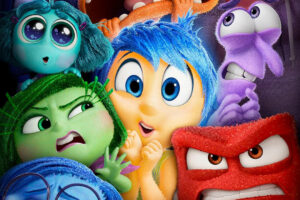By Brontë H. Lacsamana, Reporter
Movie ReviewInside Out 2Directed By Kelsey Mann
THE HEADQUARTERS of human emotions once again undergoes a major renovation for all to see in Inside Out 2, as protagonist Riley enters puberty and grapples with new feelings like anxiety, envy, embarrassment, and ennui. Director Kelsey Mann’s debut animated film stands on the shoulders of its mega-hit predecessor from 2015, keeping its footing and expanding the world just enough to bring deeply cutting yet kid-friendly revelations to the forefront.
The key emotions — Joy, Sadness, Anger, Fear, and Disgust — retain lively personifications, with four more ingeniously crafted feelings to contend with. The film explains concepts like panic attacks, a sense of self, and suppressed emotions in colorful ways, allowing young teenage audience members to recognize their own struggles.
But Inside Out 2 plays it safe. Understandably so, since Pixar’s last few films (Luca, Turning Red, Elementals) weren’t received too well despite being cathartic creative endeavors for their respective filmmakers. This sequel involves a similar adventure-style journey as the first, with the lead emotion, Joy, once again traversing the landscape of the mind and later finding out the truths of helping Riley grow.
Moments of crisis and inner turmoil are represented well, though the structure of the feelings trying to work things out in the headquarters (Riley’s brain) and beyond can get old. Complex experiences can come off as flat and didactic, but at the same time still sweet, funny, and sometimes inspiring, which is perhaps enough for a film that hopes to mirror and make sense of the struggles of today’s overwhelmed youth.
The new emotions are portrayed with as much personality as the initial five. Adele Exarchopoulos turns in an appropriately nonchalant performance as Ennui while Maya Hawke embodies the never-ending nervous energy of Anxiety (truly a voice you wouldn’t want in your head, rattling off all the worst-case scenarios). Paul Walter Hauser barely spoke, which makes sense but reflects the movie underutilizing Embarrassment, the key driver behind people toning down their true selves as they grow up. Maybe in part due to personal preference, it was Ayo Edebiri who provided the most fitting new voice as Envy by subtly playing up points of pronunciation to sound cartoonishly jealous.
Something to ponder when it comes to Inside Out 2 is how it is fast becoming the biggest blockbuster of the year, surpassing the likes of Dune: Part Two, The Fall Guy, and Godzilla x Kong: A New Empire. According to a report from the Philippine Star, its opening day amassed P88.8 million locally, the third biggest of all time opening behind the two Avengers movies released in 2018 and 2019.
There are a few likely reasons behind this: the film hit theaters on a midweek holiday — June 12, Independence Day — and enjoyed further success that weekend which celebrated Father’s Day. Students are also currently on their summer break. Beyond the logistics, however, Inside Out 2 is a representation of mental health awareness that resonates with the youth now more than ever. Of all generations, Gen Z is remarkably in tune with their inner conflicts (for better or for worse), exacerbated by their isolation during the pandemic.
While this sequel is merely a safe retreading of the familiar ground built by the 2015 film, its new additions form a relatable scenario of how clashing, suppressed emotions and memories can affect a developing mind. Anxiety is an effective villain of the puberty stage, perhaps even hitting too close to home for some, while the forming of the sense of self may bring tears to adults who remember how their own journey may have been as difficult as Riley’s.
Of course, many of the thoughtful associations with real-life processes are played as jokes, some working better than others. The sar-chasm is born out of the teenager’s new weapon — the sarcastic voice — while literal brainstorms bring forth a smattering of ideas both good and bad. The secret vault filled with dark secrets is hilarious to those who’ve had an annoyingly endearing former childhood cartoon or embarrassingly attractive animé character stuck in their heads.
One gag that felt cheap was the premature introduction of another emotion, Nostalgia, taking the form of an old woman reminiscing about the past before the others push her out for arriving “too early.” Her existence undermines the revelation from the first film that memories marked by Joy and Sadness make up a bittersweet melancholy. Nostalgia isn’t an emotion per se, but a result of reliving that mix of the joyful and sad, a poignant take on the feeling that is now just played for laughs.
Inside Out 2 is full of such gimmicks, though it must be said that at its heart is a core structure that allows Riley’s growing up to be seen as a painful yet essential journey. While it speedruns puberty within three days (a very limiting choice that flattens what should be more complex, lived-in conflicts), the personification of Anxiety and the formation of the sense of self are what make this film. Ultimately, it’s a sincere and crucial film for young people to see; despite its flaws, that should count for something.





